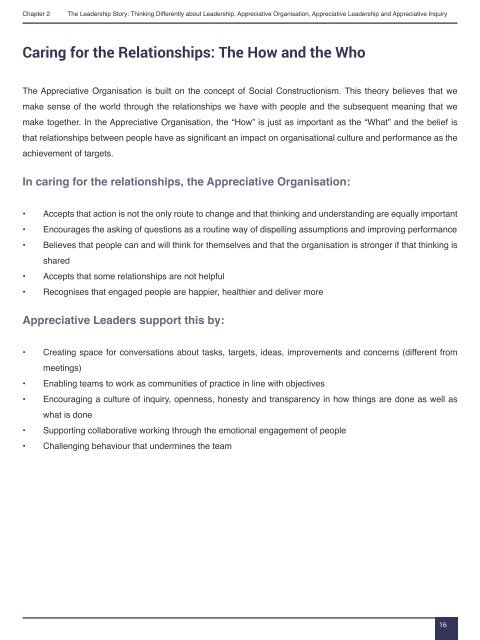Appreciative-Leadership
Appreciative-Leadership
Appreciative-Leadership
You also want an ePaper? Increase the reach of your titles
YUMPU automatically turns print PDFs into web optimized ePapers that Google loves.
Chapter 2<br />
The <strong>Leadership</strong> Story: Thinking Differently about <strong>Leadership</strong>, <strong>Appreciative</strong> Organisation, <strong>Appreciative</strong> <strong>Leadership</strong> and <strong>Appreciative</strong> Inquiry<br />
Caring for the Relationships: The How and the Who<br />
The <strong>Appreciative</strong> Organisation is built on the concept of Social Constructionism. This theory believes that we<br />
make sense of the world through the relationships we have with people and the subsequent meaning that we<br />
make together. In the <strong>Appreciative</strong> Organisation, the “How” is just as important as the “What” and the belief is<br />
that relationships between people have as significant an impact on organisational culture and performance as the<br />
achievement of targets.<br />
In caring for the relationships, the <strong>Appreciative</strong> Organisation:<br />
• Accepts that action is not the only route to change and that thinking and understanding are equally important<br />
• Encourages the asking of questions as a routine way of dispelling assumptions and improving performance<br />
• Believes that people can and will think for themselves and that the organisation is stronger if that thinking is<br />
shared<br />
• Accepts that some relationships are not helpful<br />
• Recognises that engaged people are happier, healthier and deliver more<br />
<strong>Appreciative</strong> Leaders support this by:<br />
• Creating space for conversations about tasks, targets, ideas, improvements and concerns (different from<br />
meetings)<br />
• Enabling teams to work as communities of practice in line with objectives<br />
• Encouraging a culture of inquiry, openness, honesty and transparency in how things are done as well as<br />
what is done<br />
• Supporting collaborative working through the emotional engagement of people<br />
• Challenging behaviour that undermines the team<br />
16


